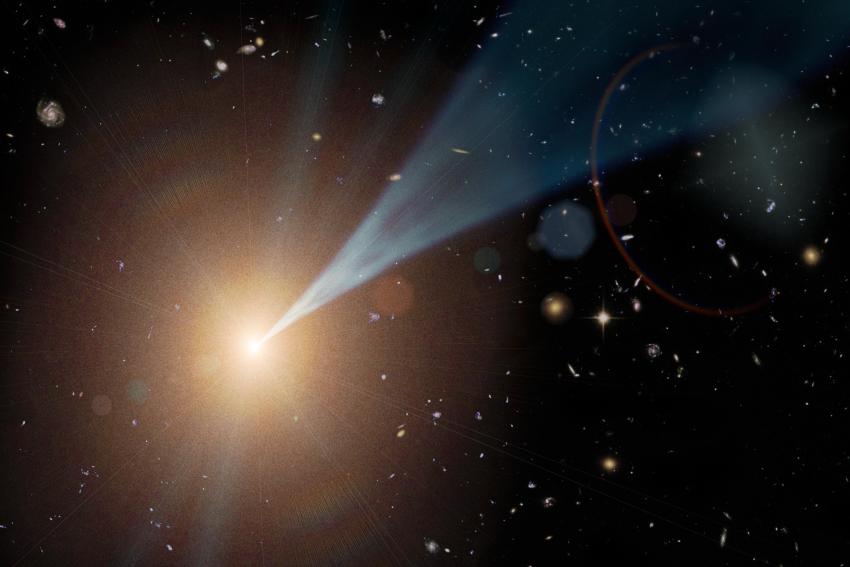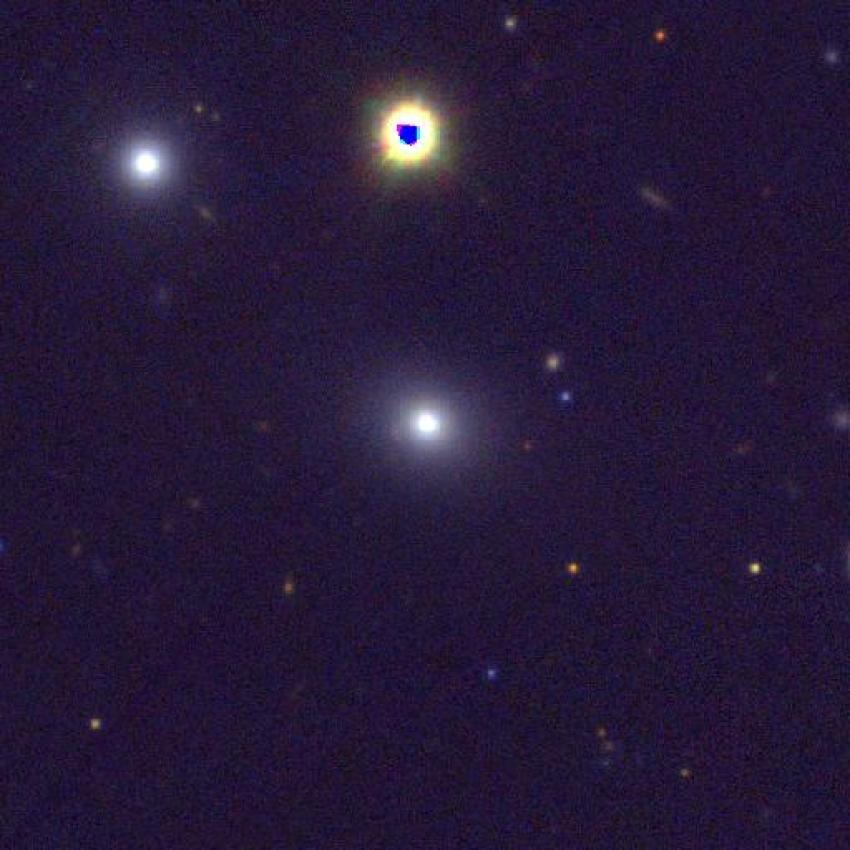A team of international astronomers have discovered a galaxy that has changed classification due to unique activity within its core. The galaxy, named PBC J2333.9-2343, was previously classified as a radio galaxy, but the new research has revealed otherwise. The work is published in Monthly Notices of the Royal Astronomical Society.
PBC J2333.9-2343, located 656 844 372 light years away, has now been classified as a giant radio galaxy that is 4 million light years across and happens to have a blazar in its core; a blazar is an active galactic nucleus (AGN) with a relativistic jet (a jet travelling close to the speed of light) directed towards an observer. Blazars are very high energy objects and are considered to be one of the most powerful phenomena in the Universe. The research has revealed that in PBC J2333.9-2343, the jet changed its direction drastically by an angle of up to 90 degrees, going from being in the plane of the sky, perpendicular to our line of sight, to pointing directly towards us.
A blazar jet is made of elemental charged particles like electrons or protons that move at velocities close to the speed of light. These move in circles around a strong magnetic field, causing the emission of radiation across the entire electromagnetic spectrum. In PBC J2333.9-2343, the jet is thought to originate from or close to the supermassive black hole in its centre.
With the jet pointing in our direction, the emission is strongly enhanced and can easily exceed that coming from the rest of the galaxy. This in turn drives high-intensity flares stronger than those coming from other radio galaxies, thus changing its categorisation.
The orientation of the jets to us determines how a galaxy is classified. When two jets point towards the plane of the sky, they are classified as a radio galaxy, but if one of the jets points towards us, then the AGN of the galaxy is known as a blazar. With jets in the plane of the sky and one directed at us, PBC J2333.9-2343 has been reclassified as a radio galaxy with a blazar at its centre.
Changes in the direction of jets have been described in the past, for example with X-shaped radio galaxies. This is the first time that such a phenomenon has been observed where it does not suggest the presence of two different phases of jet activity from its morphology observed at radio frequencies – the direction change appears to have taken place in the same nuclear outburst originating from the AGN.
To find out more about this mysterious galaxy, astronomers had to observe it across a wide range of the electromagnetic spectrum. PBC J2333.9-2343 was observed with radio, optical, infrared, x-ray, ultraviolet and gamma ray telescopes. Data was obtained from the German 100m-Radio Telescope Effelsberg at the Max Planck Institute for Radio Astronomy, the Yale University 1.3m-SMARTS optical telescope, and the Penn State Neil Gehrels Swift Observatory.
The team then compared the properties of PBC J2333.9-2343 with large samples of blazars and non-blazar galaxies provided by the ALeRCE (Automatic Learning for the Rapid Classification of Events) project in Chile with data from the Zwicky Transient Facility (ZTF) and the Asteroid Terrestrial-impact Last Alert System (ATLAS).
Using the observational data, the team concluded that this galaxy has a bright blazar in the centre, with two lobes in the outer areas of the jet. The lobes that are observed are related to the old jets and are no longer being fed by the emission from the nucleus, so these lobes are relics of past radio activity. The AGN no longer drives the lobes as seen in typical radio galaxies.
The team do not yet know what caused the drastic change in direction of the jets. They speculate that it could have been a merging event with another galaxy or any other relatively large object, or a strong burst of activity in the galactic nucleus after a dormant period.
Dr Lorena Hernández-García, lead author of the paper and researcher at the Millenium Institute of Astrophysics, says “We started to study this galaxy as it showed peculiar properties. Our hypothesis was that the relativistic jet of its supermassive black hole had changed its direction, and to confirm that idea we had to carry out a lot of observations.”
She adds, “The fact that we see the nucleus is not feeding the lobes anymore means that they are very old. They are the relics of past activity, whereas the structures located closer to the nucleus represent younger and active jets.”
Media Contacts
Gurjeet Kahlon
Royal Astronomical Society
Mob: +44 (0)7802 877 700
press@ras.ac.uk
Dr Robert Massey
Royal Astronomical Society
Mob: +44 (0)7802 877699
press@ras.ac.uk
Makarena Estrella Pacheco
Millennium Institute of Astrophysics (MAS)
Science Contacts
Dr Lorena Hernández-García
Millennium Institute of Astrophysics (MAS) and University of Valparaiso
lorena.hernandez@uv.cl
Dr Francesca Panessa
Institute for Space Astrophysics and Planetology (INAF-IAPS)
francesca.panessa@inaf.it
Dr Gabriele Bruni
Institute for Space Astrophysics and Planetology (INAF-IAPS)
gabriele.bruni@inaf.it
Further information
The research appears in ‘Multiwavelength monitoring of the nucleus in PBC J2333.9-2343: the giant radio galaxy with a blazar-like core’, Hernández-García et al., Monthly Notices of The Royal Astronomical Society, in press.
Images and captions
Image: https://ras.ac.uk/media/1344
Caption: This artist's concept shows a "feeding," or active, supermassive black hole with a jet streaming outward at nearly the speed of light. Not all black holes have jets, but when they do, the jets can be pointed in any direction. If a jet happens to shine at Earth, the object is called a blazar.
Credit: NASA/JPL-Caltech
Notes for Editors
The Royal Astronomical Society (RAS), founded in 1820, encourages and promotes the study of astronomy, solar-system science, geophysics and closely related branches of science. The RAS organises scientific meetings, publishes international research and review journals, recognises outstanding achievements by the award of medals and prizes, maintains an extensive library, supports education through grants and outreach activities and represents UK astronomy nationally and internationally. Its more than 4,000 members (Fellows), a third based overseas, include scientific researchers in universities, observatories and laboratories as well as historians of astronomy and others.
All submissions to RAS journals undergo peer review, and their suitability for publication is assessed by appropriate specialist subject editors. The Society issues press releases based on a similar principle, but the organisations and scientists concerned have overall responsibility for their content.
Keep up with the RAS on Twitter, Facebook, Instagram, LinkedIn, and YouTube.



